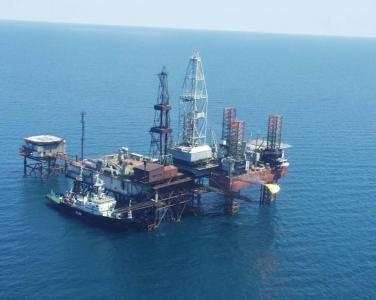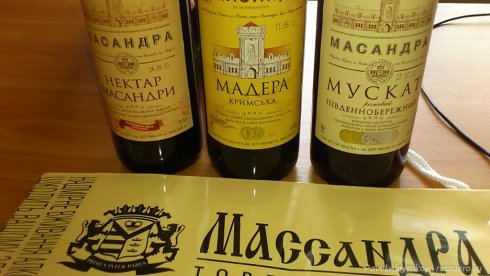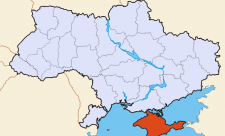Annexation of Crimea is not only the violation of rules of international law, disregard of the territorial integrity of the independent state, but also significant politico-military and economic losses for Ukraine. The Minister of Justice Pavel Petrenko assessed the damage from the loss of Crimea at 1 trillion and 200 billion hryvnyas. However, not everything can be measured in terms of money – the price of intangible assets is much higher. We defined 5 nominations in our ranking of the most serious losses for Ukraine: economy, military sector, brand, tourism and people.
Economy
 An absolute leader among the losses for Ukrainian economy was the nationalization of the Chornomornaftogaz oil and gas company, which owns 17 deposits of the Black Sea shelf and large-scale infrastructure for natural gas extraction, performed by the Crimean “authorities”. Since 2013 the company increased its gas production up to 1.65 billion cubic meters and planned to increase the volumes of production up to 5 billion cubic meters in 2016. With that, the peninsula itself consumed the lion’s share of produced gas, so after the annexation the real losses for Ukraine would be possible only in the case of the further growth of gas production.
An absolute leader among the losses for Ukrainian economy was the nationalization of the Chornomornaftogaz oil and gas company, which owns 17 deposits of the Black Sea shelf and large-scale infrastructure for natural gas extraction, performed by the Crimean “authorities”. Since 2013 the company increased its gas production up to 1.65 billion cubic meters and planned to increase the volumes of production up to 5 billion cubic meters in 2016. With that, the peninsula itself consumed the lion’s share of produced gas, so after the annexation the real losses for Ukraine would be possible only in the case of the further growth of gas production.
However, it is quite real to assess the extent of damage from the loss of the extractive infrastructure: “Boyko’s platforms” that were bought at unreasonably high prices on credit cost Ukraine 1.5 billion dollars. According to the Minister of Energy and Coal Industry of Ukraine Yuriy Prodan, total losses in the area of hydrocarbon production in Crimea and on the shelf amounted to not less than 300 billion dollars.
Navy
 The loss of Crimea significantly weakened positions of Ukraine as a naval power, because there was the base of the Ukrainian Navy deployed here. The day after the “referendum”, on March 19, 2014, the Crimean “self-defense forces” blocked and then seized the headquarters of the Ukrainian Naval Forces in Sevastopol. In March 2014, the majority of ships hoisted the Russian flag. According to the information of the Commander-in-Chief of the Russian Navy Chirkov, there were 79 Ukrainian Navy ships, including 25 combat vessels that Ukraine started to withdraw from Crimea as of April 1.
The loss of Crimea significantly weakened positions of Ukraine as a naval power, because there was the base of the Ukrainian Navy deployed here. The day after the “referendum”, on March 19, 2014, the Crimean “self-defense forces” blocked and then seized the headquarters of the Ukrainian Naval Forces in Sevastopol. In March 2014, the majority of ships hoisted the Russian flag. According to the information of the Commander-in-Chief of the Russian Navy Chirkov, there were 79 Ukrainian Navy ships, including 25 combat vessels that Ukraine started to withdraw from Crimea as of April 1.
However, as the military expert Dmitriy Tymchuk reported, they could withdraw not all vessels. “There are 11 combat vessels and boats, 6 support ships and boats, 2363 units of automobile, armored and special-purpose vehicles, 6 coastal anti-ship systems left in Crimea,” he said. The total cost of only tangible assets belonging to the Ukrainian Naval Forces that were left in Crimea amounted to 1.5 billion hryvnyas.
In addition, the Russians got the entire infrastructure – bases, depots, the helicopter aviation research center in the village Primorskoye, the unique training facility NITKA (Land-based Naval Aviation Testing and Training Complex) to train pilots. Also Russia didn’t return a great part of aviation deployed at the airfield “Belbek” and some aircrafts from the air brigade in Saki. It is difficult to estimate a full damage cost.
Brand
 Crimea was famous for several brands, but, perhaps, one of the most famous brand names in the world market was the Massandra winery that was nationalized by the local “authorities” as fast as the Chornomornaftogaz company and then transferred to the Department for Presidential Affairs of the Russian Federation.
Crimea was famous for several brands, but, perhaps, one of the most famous brand names in the world market was the Massandra winery that was nationalized by the local “authorities” as fast as the Chornomornaftogaz company and then transferred to the Department for Presidential Affairs of the Russian Federation.
The NGO “Massandra” produced about 10 million bottles of wine, 50 % of which were exported, a year. In 2013 Massandra exported its products to 12 countries. The wine White Muscat of Red Stone produced at the plant has got several prestigious awards at international competitions – Super Grand Prix, three Grand Prix cups and 21 gold and silver medals.
The Minister of Agrarian Policy and Food of Ukraine Aleksey Pavlenko assured that Ukraine is planning to reserve the Crimean brands by re-registering the enterprises in the mainland. However, it is hardly possible to establish the bottling of a wide range of the Crimean wines in the mainland without classical Crimean wine-making materials.
Tourism
 Since the Soviet times, Crimea reserved the status of the “all-union health resort” and kept it while being a part of independent Ukraine. The unique climate, the long coastal area, a variety of health resorts and hotels – all this made the region famous as the Ukrainian resort “Mecca”. Now a tourist flow to the peninsula reduced drastically.
Since the Soviet times, Crimea reserved the status of the “all-union health resort” and kept it while being a part of independent Ukraine. The unique climate, the long coastal area, a variety of health resorts and hotels – all this made the region famous as the Ukrainian resort “Mecca”. Now a tourist flow to the peninsula reduced drastically.
Crimean health resorts also got under the “wheels” of nationalization – a total about 200 facilities, most of which were state owned (besides the Kolomoyskiy’s and Taruta’s property) and didn’t bring a tangible income, were transferred to the ownership of the “Republic of Crimea”.
There is a rather different problem here: after the annexation Ukrainians lost the opportunity to spend their vacation in Crimea – today not many of them will take the risk to go to the occupied territory, especially at a time when the Crimean “prosecutor” said about the possible consequences for them.
Let’s not forget that Crimea is not only the beaches, sanatoriums and hotels, it is also a large variety of cultural artifacts. In 2014, there were 7 Ukrainian objects, one of which is located in Crimea (the Chersonesus ancient city), in the UNESCO World Heritage list. There are 6 Crimean objects – the Khan’s Palace in Bakhchisaray, the Genoese Fortress, the Crimean Astrophysical Observatory and Mangup-Kale, Chufut-Kale and Eski-Kermen cave towns – among the 15 candidates to be added to this list.
People
But the most serious problem is people’s lives crushed by the annexation. It is impossible to compensate for the loss of home, homeland, family, relatives and friends by any material benefits.
The first victims of the Russian aggression were 3 people – two Ukrainian military (Stanislav Karachevskiy and Sergey Kokurin) and the Crimean Tatar activist Reshat Ametov. In the autumn of 2014, the 25-year-old Edem Asanov and 18-year-old Belyal Bilyalov disappeared and then were found dead. More than 10 people are under arrest on a charge of various crimes – starting from the beating of a Berkut officer on the Maidan and ending with the participation in the protest meeting near the Supreme Council of ARC in February 26, 2014.
According to the Russian Ombudsman, in Crimea 156 people, including 13 Crimean Tatars, 24 Ukrainians and 119 Russians, went missing for a year of the annexation. According to the Amnesty International, 7 people, including 6 Crimean Tatars, were kidnapped. According to the information of the National Security and Defense Council of Ukraine as of December 2014, 21 Crimean Tatars disappeared.
In March 2014, dozens of people went through the torture chambers of the Crimean “self-defense forces” while being tortured and abused.
According to official statistics, about more than 20 thousand Crimeans left the peninsula after the annexation. But it is just those people, who registered in the mainland. In fact, a number of such people is a lot more. Hundreds of thousands of people still live in occupation without any opportunity to leave. Unknown fate awaits them.
Ukrainians will get through without Crimean gas and Crimean wines, they will find a replacement of Crimean beaches. It will be more difficult to build a security system within the framework of the Black Sea without Crimea. Sooner or later those people who left the peninsula will find their place in the sun with the help of the state or without it. The situation with those people who stayed there and left unprotected in the face of the Russian occupants is more difficult. Human losses will increase until Ukraine can provide people with real protection by itself or in alliance with international organizations.












